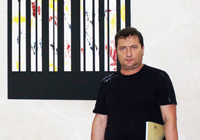IL DISORDINE ORDINATO
di Enrico Manera

Non è facile riconoscere il segno di un artista informale o astratto, eppure quello di Twombly, che ebbi la fortuna di incontrare nel suo studio di via Monserrato a Roma, eccome se lo riconosci. Ho ancora negli occhi quello di Vedova, con cui mi trattenni in un lungo colloquio accanto ad una sua opera esposta alla Biennale di Venezia nel 1999, ancora i segni di Turcato, con il quale varcai l’ingresso del Palazzo delle Esposizioni a Roma nel 1979 per visitare un’antologica di Mario Schifano : era fine giugno e il maestro indossava un goffo cappotto, faceva caldo ma lui sembrava soffrire lo stesso il freddo. Sinisi mi ricorda molto gli artisti citati.
E’ faticoso per uno come me accettare l’arte “astratta” o “informale” ma è arte. Con la “A” maiuscola, è sono molti i creativi che in quel vortice si sono cimentati. Certo è un viaggio pieno di interrogativi, come con l’arte povera, poi ripensandoci dietro quei segni quali linee all’apparenza ingarbugliate, si nasconde qualcosa, è celato ma sai che c’è, lo percepisci scoprendolo lentamente. Sinisi è coinvolto dalle sue opere e preferisce il disordine del segno, piuttosto che la mediocrità dell’esplicito. Per questo è un artista. Scegliere strade difficili, all’apparenza misteriose e incomprensibili è ciò che dovrebbe fare ogni creativo, per questo ammiro coloro che nelle facce caleidoscopiche della pittura si avviano, le percorrono, le attraversano si impastano. Sinisi è un avventuriero dell’arte, un esploratore che si diverte a tracciare molteplici linee, segni, cancellature e così ogni volta disfà e rifà le valigie del suo immaginario per un viaggio finito, interrotto o da ricominciare.
The ordered disorderBy Enrico Manera
It is not easy to recognize the sign of an artist defined as informal or abstract, but even so, you can certainly recognize the one by Twombly, who I met in his atelier in Rome, Monserrato Street. I still have in my eyes that one by Vedova, who I had a long talk with near one of his works shown at the Biennale of Venice in 1999, or the signs by Turcato, who I went with through the doors of Palazzo delle Esposizioni in Rome in 1979 to see an anthological exhibition by Mario Schifano: it was the end of June and our master was wearing a clumsy coat, it was hot but he seemed to feel cold all the same. Sinisi reminds me of these artists a lot.It is hard for me to accept the “Abstract or informal” art, but it is art. With a capital “A”, and there are many creatives who tried that vortex. Of course, it is a very questioning journey, as with “poor art”, and then, thinking back, behind those signs as lines apparently confused, something hides, it is hidden but you know it is there, you perceive it after a slow discovery. Sinisi is involved by his works and prefers the disorder of the sign, rather than the mediocrity of the” explicit”. That is why he is an artist.To run difficult roads, apparently mysterious and sometimes incomprehensible is what every creative should do, that is why I admire those who go, run, cross, paste into the kaleidoscopic faces of painting. Sinisi is an adventurer of art, an explorer who enjoys drawing a lot of lines, signs, erasures and, in this way, he packs and unpacks the cases of his unconscious, for an ended, stopped or to be started again journey.